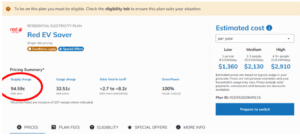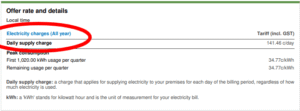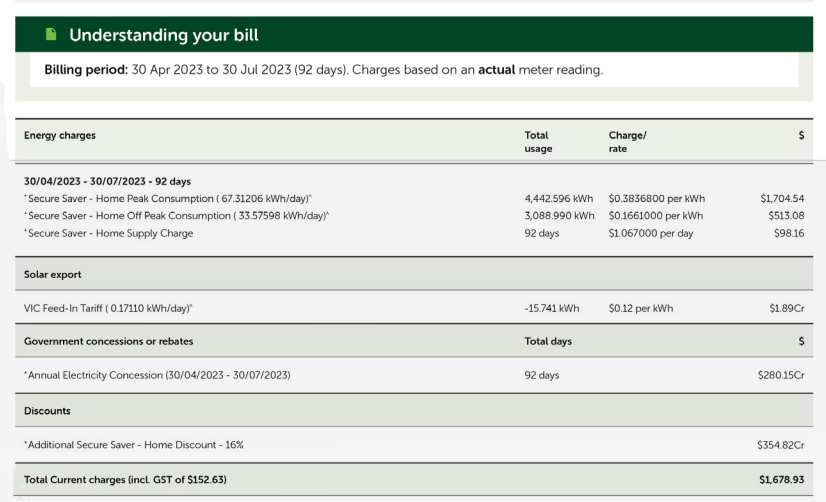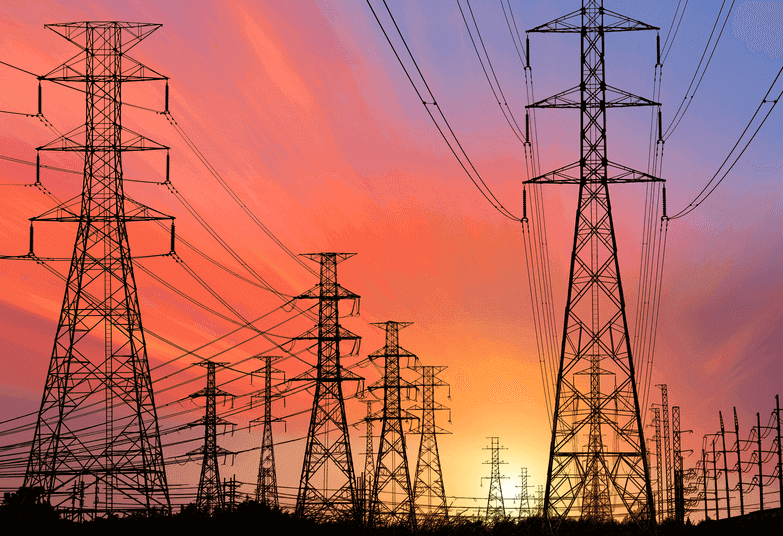KEY POINTS
- An electricity supply charge is a daily fee that households pay to be connected to the electricity grid.
- It is not related to how much electricity you use, and will appear on your electricity bill even if your household has not used any electricity.
- The electricity supply charge pays for the maintenance of electricity poles and wires, as well as general upkeep by the energy distributor.
On this page:
- What are supply charges?
- How much are electricity supply charges per day in Australia?
- Where do I find the daily supply charge for electricity on my bill?
- Why is there more than one electricity supply charge on my bill?
- When do electricity supply charges change?
- Why are electricity supply charges important?
What are supply charges?
Supply charges are the fixed, daily costs you pay to remain connected to the grid, regardless of the amount of energy you use.
Supply charges are set by energy providers (or government regulators in regulated markets), which typically include network charges passed on by the energy distributor in your area.
These network charges (or distribution costs) help finance the maintenance of grid infrastructure (i.e. utility poles and wires).
Supply charges can range from about 90c per day to $1.90 per day, depending on:
- Your energy retailer
- If where you live is a regulated or deregulated market
- Your energy distributor.
Supply charges can also be called:
- Fixed charges
- Daily supply charges
- Service charges (or service to property charges).
How much are electricity supply charges per day in Australia?
Canstar Blue has calculated the average electricity supply charge in cents per day (c/day) for single rate tariffs across each distribution network in NSW, VIC, SEQ, SA, the ACT and TAS.
← Mobile/tablet users, scroll sideways to view full table →
| State | Distribution Network | Average Electricity Supply Charge (c/day) |
|---|---|---|
| NSW | Ausgrid | 107.5c |
| NSW | Endeavour Energy | 118.7c |
| NSW | Essential Energy | 192.0c |
| VIC | AusNet Services | 125.0c |
| VIC | Citipower | 110.5c |
| VIC | Jemena | 110.2c |
| VIC | Powercor | 123.1c |
| VIC | United Energy | 104.3c |
| QLD | Energex | 134.8c |
| SA | SA Power Networks | 124.7c |
| ACT | Evoenergy | 136.0c |
| TAS | TasNetworks | 130.5c |
| Source: www.canstarblue.com.au – 15/07/2025. Average electricity usage rates are based on non-solar only plans on Canstar’s database for each respective rate type (single rate and controlled load), available for annual usages based on the reference usage amounts for each distributor for controlled load plans: NSW, VIC, QLD, and SA per AER, VIC per Victorian Default Offer, ACT per ICRC, TAS per the mdian usage in the Office of the Tasmanian Regulator’s report, Typical Electricity Customers in Tasmania 2022. Controlled load supply charges based on plans that have a supply charge for controlled loads. In Queensland, the tariffs are more commonly referred to as tariff 11 (single rate), tariff 31 (controlled load 1), and tariff 33 (controlled load 2). In Tasmania, the tariffs are more commonly referred to as tariff 31 (single rate), tariff 41 (controlled load). |
Where do I find the daily supply charge for electricity?
The daily supply charge (shown as cents per day) for your current energy plan can be found in either its energy fact sheet or a recent power bill.
On a plan’s energy fact sheet
Energy price fact sheets are detailed documents outlining all your plan’s charges, discounts, benefit terms, hidden charges and any other conditions.
In NSW, QLD and SA, energy fact sheets are referred to as basic product information documents (BPID).
BPIDs for different plans are stored on the Energy Made Easy (EME) database and are accessible directly or on the energy retailer websites offering those plans — typically organised in a database with a search function and filters.
Once you’ve found your plan’s BPID on EME, you’ll have to enter your home’s postal code to access it. Usage charges can be found under the ‘pricing summary’ section.
In this example, the Red EV Saver plan charges 94.59c per day.

Image: Red Energy
In VIC, energy fact sheets are called Victorian Energy Fact Sheets (VEF). Unlike BPIDs, VEFs can only be found on each retailer’s database or library as a PDF.
A Victorian energy plan’s usage charges can be found under the ‘Electricity charges (All year)’ section on each VEF.
In this example, the Flow Energy Standing Offer plan charges 141.46c per day.

Image: Flow Energy
You can also find usage and supply charges for plans in VIC by searching the Victorian Energy Compare database.
On your power bill
In the example below, this Victorian customer pays $1.067000 per day for electricity supply (or ‘home supply charge’), which adds up to $98.16 over a 92-day billing period.

Image: EnergyAustralia
Why is there more than one electricity supply charge on my bill?
Households with a controlled load tariff, in addition to their standard tariff, will be charged an extra daily supply charge.
This is because a controlled load is a separately metered tariff for larger appliances like hot water systems, which could also attract a daily electricity supply charge.
Whether you need to pay this extra electricity supply charge depends on which energy distribution network you live in.
These costs are usually small in comparison to standard electricity supply charges, often just three or four cents per day.
When do electricity supply charges change?
Households on a fixed rate plan have their supply charges locked in for a set period. Electricity supply and usage charges are generally amended every 12 months – usually in July in most areas.
In comparison, if you’re on a variable rate market offer, electricity retailers can change their electricity supply charges whenever they want to, provided they give written notice to customers. Some energy companies change their prices regularly.
So it’s important to be mindful of your bills as well as any other communications from your electricity retailer, which may include information about upcoming price changes.
Why are electricity supply charges important?
Supply charges are often overlooked in favor of usage charges — charges that vary with every kilowatt hour (kWh) of actual energy use.
However, supply charges are extremely relevant for households that don’t use much electricity.
For example, low-energy users will be billed less for their energy use. Instead, supply charges will reflect a higher proportion of their bill. In this situation, they could be overpaying to supply energy to their homes.
It is extremely important for Aussies who aren’t energy-guzzlers to focus on lower supply charges when shopping around for a new energy plan.
Even if you aren’t in the market for a new plan, proactively comparing energy plans ensures you’re not missing out on other competitive deals.
However, the same could be said about the opposite scenario. If you’re a high-power user, usage charges will form the bulk of your power bill, more so than supply charges. Searching for a plan with cheaper usage rates will help you save more money.
As a rule of thumb, if you find a plan with low usage rates, the retailer may compensate for this with higher electricity supply costs, and vice versa.
Regardless of which situation you find yourself in, we strongly recommend comparing some of the cheapest energy plans from each state in the table below.
Energy deals with cheap electricity rates
Here are some of the cheapest published deals from the retailers on our database that include a link to the retailer’s website for further details. These are products from referral partners†. These costs are based on the Ausgrid network in Sydney but prices may vary depending on your circumstances. This comparison assumes general energy usage of 3900kWh/year for a residential customer on a single rate tariff. Please use our comparison tool for a specific comparison in your area. Our database may not cover all deals in your area. As always, check all details of any plan directly with the retailer before making a purchase decision.
Here are some of the cheapest published deals from the retailers on our database that include a link to the retailer’s website for further details. These are products from referral partners†. These costs are based on the Citipower network in Melbourne but prices may vary depending on your circumstances. This comparison assumes general energy usage of 4000kWh/year for a residential customer on a single rate tariff. Please use our comparison tool for a specific comparison in your area. Our database may not cover all deals in your area. As always, check all details of any plan directly with the retailer before making a purchase decision.
Here are some of the cheapest published deals from the retailers on our database that include a link to the retailer’s website for further details. These are products from referral partners†. These costs are based on the Energex network in Brisbane but prices may vary depending on your circumstances. This comparison assumes general energy usage of 4600kWh/year for a residential customer on a single rate tariff. Please use our comparison tool for a specific comparison in your area. Our database may not cover all deals in your area. As always, check all details of any plan directly with the retailer before making a purchase decision.
Here are some of the cheapest published deals from the retailers on our database that include a link to the retailer’s website for further details. These are products from referral partners†. These costs are based on the SA Power network in Adelaide but prices may vary depending on your circumstances. This comparison assumes general energy usage of 4000kWh/year for a residential customer on a single rate tariff. Please use our comparison tool for a specific comparison in your area. Our database may not cover all deals in your area. As always, check all details of any plan directly with the retailer before making a purchase decision.
Frequently asked questions about supply charges
An electricity usage charge, also known as a consumption charge or variable charge, reflects the cost of the electricity you use in your home.
It’s the amount you pay for every kilowatt hour (kWh) of electricity that your household consumes each day.
An electricity usage charge is shown as cents per kilowatt hour (c/kWh). It’s typically noted on the second page or the back of your bill. Below is an example of a bill showing electricity usage rates:

Image: AGL
This is because there are multiple tariff types available, which may be broken down into different periods.
Depending on factors like your supplier or distribution network, your bill may show:
- Single rate tariff: usually called anytime, peak, flat or standard rate on your electricity bill. This is typically your main tariff.
- Time of use tariff: includes peak (usually weeknights where electricity costs the most), shoulder (rate that is less than peak) and off peak times (cheapest rate overnight and on weekends).
- Controlled load tariffs: separate metered tariffs charged at a lower price.
In our example bill, the household has a peak and off-peak charge, as well as a supply charge.
For more information about how tariffs work, visit Canstar’s Blue’s guide to all things tariff-related.
Electricity usage charges are set by individual energy retailers, or by state governments, depending on whether you live in a state with a deregulated electricity market.
VIC, NSW, SEQ and SA are deregulated, which means electricity retailers are free to set their own usage charges, along with various other rates.
In WA, NT, TAS and regional QLD, households have their electricity usage charges set by their respective governments.
In most areas, electricity retailers set their usage charges and can change them whenever they like, provided the customer is on a variable rate plan and they’ve been given notice.
Customers on a fixed rate energy plan see their electricity usage charges locked in for a set period. In terms of when prices change, this depends on factors like the particular provider and location.
As a general rule, usage and supply rates are amended every 12 months – in NSW, SEQ, VIC, SA, TAS and the ACT, this happens in July. Some electricity retailers may also change their prices regularly.
To help you start comparing energy providers and plans, click the link below to use Canstar Blue’s comparison tool.



Share this article